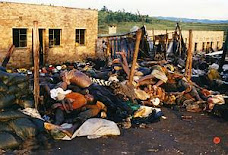Who Was Behind the Rwandan Genocide? Debunking the "Hutu Extremist" Myth
Who Was Behind the Rwandan Genocide? Debunking the "Hutu Extremist" Myth
Why the ICTR Refuses to Examine the Assassination that Triggered the Rwandan Genocide
"With the RPF…located 1 km away from the control tower and given the UN alias MINUAR's bias, we are almost certain that there are SAM 7 missiles and others posing a threat to the Falcon 50″."35
"During the 1970s, in fact, Rwanda was in good health financially and economically. This period was characterized by high economic growth rates (5 % on average), financial stability and a weak inflation rate. This situation resulted from high coffee prices and very prudent policy management. In this Rwanda, which was regarded as the "Switzerland of Africa", the illusion of socioeconomic progress was strong between 1976 and 1983." 41
"Seeing the way the wind was blowing, these opposition parties began to establish direct ties with the RPF in the hope of gaining similar international support for themselves. As a result, leaders of opposition parties and the Rwandan Patriotic Front met in Brussels from May 29 through June 3, 1992, and issued a joint press release. It turns out, in fact, that those meetings were attended by opposition parties."60
"Anyone who could pass the one-hour test qualified for a fast track training program that lasted anywhere from one to five months. At the end of it, successful candidates were declared to be qualified prosecutors, investigators, and judges. Formal education had never really been an issue in Rwanda, where only one in fifty judges of the pre-war judiciary had a degree in law."86
"If the tribunal does not handle (Habyarimana's assassination), it is because it does not have jurisdiction in the matter. It is very true that it triggered everything. But in and of itself, attacking the plane and killing the president are not acts that falls under the articles that give us jurisdiction."90
Posted by: Nzinink <nzinink@yahoo.com>
| Reply via web post | • | Reply to sender | • | Reply to group | • | Start a New Topic | • | Messages in this topic (1) |
The hate of men will pass, and dictators die, and the power they took from the people will return to the people. And so long as men die, liberty will never perish.
I have loved justice and hated iniquity: therefore I die in exile.
The price good men pay for indifference to public affairs is to be ruled by evil men.
When the white man came we had the land and they had the bibles; now they have the land and we have the bibles.
----------------------------------------------------------------------------------------------------------
The Voice of the Poor, the Weak and Powerless.
-----------------------------------------------------------
Post message: AfricaRealities@yahoogroups.com
Subscribe: AfricaRealities-subscribe@yahoogroups.com
Unsubscribe: AfricaRealities-unsubscribe@yahoogroups.com
List owner: AfricaRealities-owner@yahoogroups.com
__________________________________________________________________
Please consider the environment before printing this email or any attachments.
---------------------------------------------------------------------------------------------------------------------
-http://www.africarealities.com/
-https://www.facebook.com/africarealities
-----------------------------------------------------------------------------------------
-New International Scholarships opportunities: http://www.scholarshipsgate.com
-----------------------------------------------------------------------------------------------
Find Friends in Africa:
http://www.africanaffection.com
http://www.datinginafrica.com/
http://www.foraha.net
https://www.facebook.com/onlinedatinginafrica








No comments:
Post a Comment
Note: only a member of this blog may post a comment.